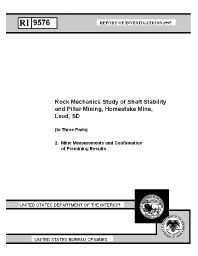 |
A U.S. Bureau of Mines case study of pillar recovery in high-grade ore near the ross shaft at the Homestake Mine, Lead, South Dakota, has demonstrated the usefulness of the finite-element method for evaluating shaft pillar mining plans and shaft stability. This report focuses on mine measurements and calibration of the two- dimensional computer model and is the second in a series of three reports of investigations describing the ross shaft study. In this study, borehole extensometers and other instruments were installed to provide data for model verification and to monitor the shaft. Results of the recalibrated two-dimensional model (Utah2) confirmed the premining stability evaluation. However, after mining began, concern was expressed because cracks and other signs of ground motion appeared at considerable distances from the area of active pillar mining. In part 3 of the study, an intense three-dimensional modeling effort using Utah3 was initiated. The results again showed that the observed effects were within expectations and that the shaft would remain safe. Three-dimensional analyses of alternative pillar mining scenarios indicated that more of the shaft pillar ore reserve could be recovered than previously thought.
| Author(s): | Pariseau-WG, Johnson-JC, McDonald-MM, Poad-ME |
| Reference: | U.S. Department of the Interior, Bureau of Mines, Report of Investigations 9576, NTIS stock number: PB96-107081, 1995 May; :1-20 |
ri9576 (PDF, 694 KB)